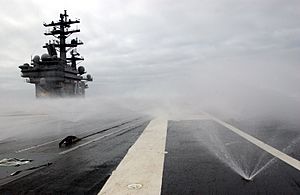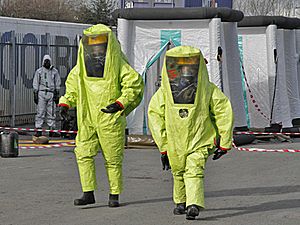CBRN defense facts for kids
Chemical, biological, radiological, and nuclear defense (often called CBRN defense) is about keeping people safe from very dangerous threats. These threats can come from chemical, biological, radiological (like dirty bombs), or nuclear attacks, including terrorism. CBRN defense involves protecting people, avoiding contaminated areas, and reducing the harm from these powerful weapons.
A CBRN event is different from a regular hazardous material spill. CBRN situations are usually much bigger, affecting many people, and are often caused on purpose. Because of this, when a CBRN incident happens, it's important to save evidence and find those responsible, more so than with typical hazardous material incidents.
Contents
- What does CBRN mean?
- CBRN defense around the world
- Brazil's CBRN readiness
- Canada's CBRN protection
- European Union's safety plans
- Hong Kong's quick response
- India's defense vehicles
- Indonesia's specialized units
- Ireland's protective forces
- Sri Lanka's CBRN Regiment
- Malaysia's defense groups
- New Zealand's defense training
- Spain's specialized forces
- Sweden's defense center
- Turkey's CBRN units
- United Kingdom's response teams
- United States' CBRN specialists
- The Russian Federation's NBC Protection Troops
- See also
What does CBRN mean?
The term CBRN has changed over time. In the 1950s, it was called ABC (atomic, biological, and chemical). Later, in the 1960s to 1980s, it became NBC (nuclear, biological, and chemical). The letter R was added to make CBRN because of the new danger from radiological weapons, also known as "dirty bombs." In the 2000s, some people started using CBRNe, where the e stands for enhanced (improvised) explosives.
In other languages, the terms can be different. For example, in Spanish, they use NRBQ (Nuclear, Radiológico, Bacteriológico y Químico).
CBRN defense around the world
Many countries have special teams and training to handle CBRN threats. Here's how some of them prepare:
Brazil's CBRN readiness
Brazilian firefighters are trained for NBC situations. During the 2016 Summer Olympics, police groups like the GATE, the Federal Police, and the National Public Security Force were ready for these threats.
The Brazilian military also has CBRN teams. The Brazilian Army has a special battalion in Rio de Janeiro that cleans military gear and people. Another company in Goiânia handles decontamination and defense. Even the Brazilian Presidential Guard has CBRN units.
The Brazilian Marine Corps has a special center that manages battalions focused on nuclear, biological, chemical, and radiological defense. These units help protect important nuclear research sites and future submarine bases. The Air Force is also training teams to transport victims from CBRN attacks or accidents.
Canada's CBRN protection
In Canada, CBRN is a common term for emergency services. The Canadian Armed Forces started using CBRN Defence in 2005 because of the increased threat of dirty bombs. They also use CBRNE. The Canadian Joint Incident Response Unit is a special military unit that helps the government prevent and manage CBRN threats.
All Canadian soldiers are trained in CBRNE defense and must pass tests every three years. Cities in Canada, like Windsor, Peterborough, Toronto, and Ottawa, also offer CBRN training for their emergency services.
European Union's safety plans
In 2016, the European Parliament worked on new rules to protect people from biological, chemical, and other attacks. These rules would make it a crime to prepare for terrorist attacks, like traveling to meet a terrorist group or training to make explosives. They also include ways to help victims of terror attacks.
Hong Kong's quick response
Hong Kong has had CBRN response teams since the early 1990s. A group called the Standing CBRN Planning Group (SRPG) plans for all CBRN incidents. This group includes experts from nine government departments, like the Police, Fire Services, and Health Department. They also have an Incident Advisory Group (RIAG) that gives real-time advice during an incident. Hong Kong regularly practices these plans with exercises every year.
India's defense vehicles
The Indian Army ordered 16 special CBRN monitoring vehicles. The first ones were put into use in 2010. These vehicles were made in India by the Defence Research and Development Organization (DRDO).
Indonesia's specialized units
Army's CBRN engineers
The Indonesian Army has a special CBRN defense unit called the "Army Engineers Nuclear, Biological, and Chemical Company." This unit was formed in 1986 and works with the Ministry of Health and nuclear agencies. It is the only unit in the Indonesian Armed Forces that can handle CBRN defense.
Police's first responders
The Indonesian National Police has a special unit called the Mobile Brigade Corps (Brimob). This unit has a CBR team that started in 2009. They are often the first to respond to bomb and terrorist threats in public areas.
Ireland's protective forces
The Irish Defence Forces have CBRNE training and equipment. Their bomb disposal teams, engineers, and special forces can help if needed. The Irish Army offers CBRNE defense courses and has detection and decontamination equipment. They also have enough protective suits for all their soldiers. All Army Reserve members also get CBRN training.
The Irish police force, the Garda Síochána, has CBRN response teams across the country. These teams started in 2004 and are trained by the Garda Tactical Training Unit. Other emergency services, like the Health Service Executive and Dublin Fire Brigade, also have some CBRN knowledge and hazardous materials units.
Sri Lanka's CBRN Regiment
The 14 CBRN Regiment of the Sri Lanka Engineers is a special unit of the Sri Lanka Army. It focuses on dealing with chemical, biological, radiological, and nuclear dangers in the country. The Sri Lanka Navy and Sri Lanka Air Force also have their own CBRN units.
Malaysia's defense groups
The Malaysian Army created a CBRN unit called the "Chemical, Biological, and Nuclear Warfare Division 3" in 2002.
The Royal Malaysia Police also has CBRN teams. Their special operations units, the 69 Commandos and Special Actions Unit, have expertise in hazardous materials. The Federal Reserve Unit also has a CBRN unit. These police teams usually respond first to CBRN calls before the army units arrive.
New Zealand's defense training
All members of the NZDF (New Zealand Defence Force) are trained in CBRN drills before they are sent on missions.
RNZN (Royal New Zealand Navy) personnel train with the NZ Army and RNZAF for any missions or exercises.
Air Force's regular drills
The RNZAF (Royal New Zealand Air Force) conducts regular training for all its staff. This is because airfields are often targets for enemy CBRN attacks. RNZAF Security Forces personnel handle all CBRN training for the Air Force and complete courses in the United Kingdom.
Army's pre-deployment training
The NZ Army teaches all CBRN training for NZDF members before they are deployed. The New Zealand Special Air Service (SAS) is also trained for operations that involve getting rid of or containing chemical agents in a CBRN situation.
Spain's specialized forces
The Spanish Army formed its 1st CBRN Regiment 'Valencia' in 2005. They hold an important exercise called 'Grifo' (Griffin) to train in defending against CBRN agents. The National Police and the Spanish Civil Guard also have their own CBRN units. The Military Emergencies Unit and other emergency services also receive CBRN training.
Sweden's defense center
The Swedish Armed Forces has a main CBRN protection force called the National CBRN Defence Centre (SkyddC) in Umeå. It has a standing company ready for action and also trains new recruits in CBRN defense.
Turkey's CBRN units
Turkey's CBRN defense units are mainly part of the Turkish Armed Forces, including a special response unit and a training center. The Gendarmerie General Command also has CBRN units. The Ministry of the Interior's Disaster and Emergency Management Presidency AFAD works with law enforcement to respond to any CBRN accidents. Turkey also makes most of its own CBRN protective clothing and equipment.
United Kingdom's response teams
In the UK, CBRN is also used by the Home Office for civilian purposes. Police, fire, and ambulance services must all have some level of CBRN training. Ambulance services have special teams called Hazardous Area Response Teams (HART) and Special Operations Response Teams (SORT). UK fire services have new equipment to clean people who have been exposed to CBRN materials, and they regularly practice these scenarios.
Army All British Army personnel are trained in CBRN during their basic training and must complete an online assessment every year. The British Army has a special regiment, 28 Engineer Regiment, dedicated to all CBRN matters. This regiment was formed in 2019 and will be fully ready by early 2023, as CBRN specialists become more important. Soldiers in this regiment train with real CBRN materials in controlled environments.
United States' CBRN specialists

The United States Army has "Chemical, Biological, Radiological, and Nuclear Operations Specialists." All soldiers who want a career in CBRN train at the United States Army CBRN School at Fort Leonard Wood.
The USAF also has CBRN Specialists. They train at the USAF CBRN School, also at Fort Leonard Wood. The USMC has CBRN Defense Officers and Specialists, who train at the Marine Corps CBRN School at Fort Leonard Wood. The Chemical Biological Incident Response Force (CBIRF) is a special unit of the USMC.
The USN requires all its personnel to take an online CBRNE training every year. This helps them understand the basics of how to respond to a CBRNE incident.
The Russian Federation's NBC Protection Troops
The Nuclear, Biological, and Chemical Protection Troops (NBC Protection Troops) of the Russian Federation are special forces. They work to reduce harm to soldiers and help them complete missions in areas affected by radiation, chemicals, or biological contamination. They also help protect soldiers from advanced weapons.
In 2015, the Russian government vaccinated about half a million reindeer against anthrax. This was done because about 1.5 million reindeer carcasses in Russian permafrost could melt due to global warming in the Arctic. If the permafrost thaws, it could release old anthrax and cause new infections in reindeer. An anthrax outbreak in 2016 caused the Russian Armed Forces to move a nomadic reindeer herding tribe to safety.
In 2012, it was reported that the Russian security service ordered over 100 "capsule cradles." These are devices that can protect babies or small pets during nuclear, chemical, biological, or radiological threats. Soviet engineers first invented these capsules in the 1960s, and a factory in Russia is now making them.
See also
 In Spanish: Defensa Nuclear, Radiológica, Biológica y Química para niños
In Spanish: Defensa Nuclear, Radiológica, Biológica y Química para niños
- Biological and Chemical Defence Review Committee (Canada)
- Biosecurity
- Bioterrorism
- Poison gas in World War I
- Hazmat suit
- HazMat team
- List of CBRN warfare forces
- Overpressure (CBRN protection)
- NBC suit




